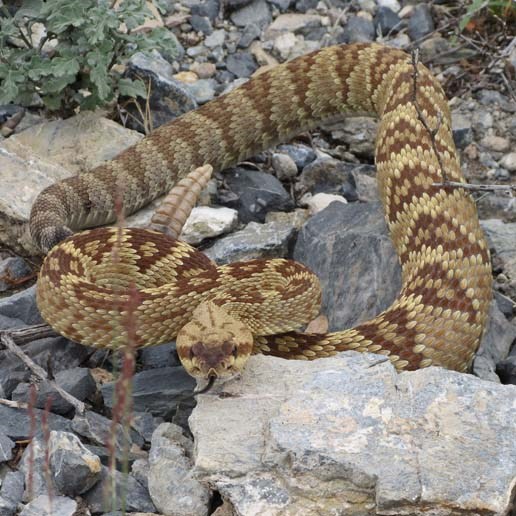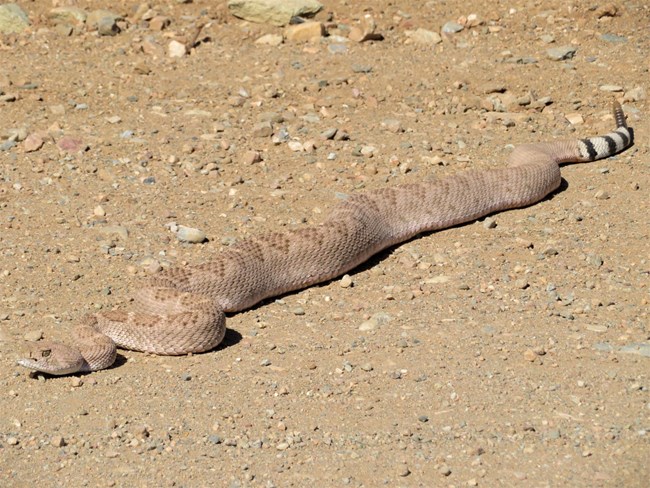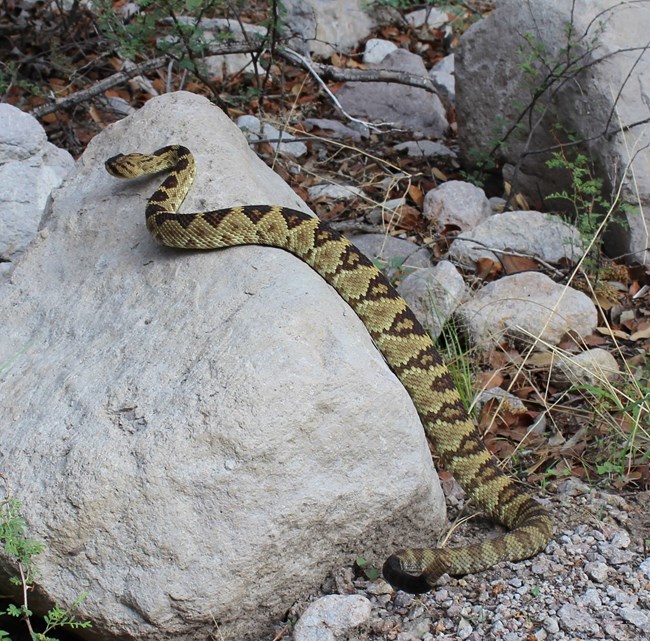
NPS Walking through the desert is a feast for the senses. The hot sun beams down, warming your skin while the dry air blows past your face. The smell of creosote and oreganillo fills your nose and your eyes take in the grassy mountain slopes dotted with juniper trees. Usually, the only sounds to be heard are the wind blowing through the trees or the mournful cooing of a dove. However, if misplace a footstep, a buzzing sound quickly swells and fills the dusty air, instantly recognizable as the threat display of one of this region’s most notorious residents: the rattlesnake. Tall tales about these animals abound, but their unique adaptations to navigate and find food in the harsh environments of the Southwest are just as fascinating. Rattlesnakes inhabit a different world than we do, and not just because they spend most of their time under a rock. While we perceive the world through our usual five senses, rattlesnakes have a few extra tools at their disposal. On their upper jaw, they have a small depression that contains a heat sensing organ, earning them the name “pit vipers”. This allows them to detect where warm-blooded animals are even on the darkest of nights. They also have an organ called the vomeronasal organ or Jacobson’s organ, a pit on the top of their mouth that detects chemical signals. When they flick their tongue out and then draw it back into their mouth, they are collecting chemicals in the air and then placing them into this organ, giving them a detailed picture of the world around them. While a contented snake will idly flick their tongue in and out of their mouth, a snake that feels threatened or scared will leave their tongue out for longer intervals and move it more slowly, collecting as much information about their surroundings as they can. When a rattlesnake’s senses tell them there is a large animal nearby that is a potential threat, they first hide, then rattle to warn the enemy away, then as a last resort, they strike. Although they will sometimes deliver a “dry bite” where they don’t release venom, the majority of strikes do contain venom injected into their target via specialized hollow fangs. The toxicology of rattlesnake venom involves a complex cocktail of chemicals that evolved to efficiently kill the rodents and small mammals they feed on. The main component this mixture is hemotoxic enzymes, which break down the cells and tissues in the body, jump starting the digestion process in their prey. A smaller portion of the venom is made up of neurotoxic enzymes, which interfere with the nervous system, leading to cardiac arrest or paralysis and stopping their prey before they run too far away. Their potent venom allows them to quickly subdue small mammals, maintaining the local rodent populations, and their venom is strong enough to still present a danger to larger animals such as humans. About 9,000 people in the U.S. are bit by rattlesnakes each year, but there are only around five deaths annually as a result of snake bites, usually as a result of an anaphylactic reaction or not getting medical attention. You can avoid an unpleasant run-in with a rattlesnake by not putting your hands or feet in places, especially rocky areas, where you can’t see if there is a snake present or not. If you hear a rattlesnake, remain still until you’ve located it, then carefully move away. If you spot a rattlesnake, keep your distance from it and move away if it starts to rattle. Despite their fearsome nature, rattlesnakes are fascinating creatures. For example, scientific observation has found that the females of some species of rattlesnakes will stay with their young to defend them for a short period of time, usually about a week or so. If you thought a mama bear wasfearsome, imagine a mama rattlesnake! Always be cautious yet appreciative of these unique animals and the role they play in the ecosystems of Southeastern Arizona. 
Western diamondback rattlesnake Crotalus atrox This is the largest rattlesnake in Arizona, growing up to seven feet long. They can be distinguished by the alternating black and white bands on their tail below their rattle, diamond shaped or round patterns along their back, and light diagonal stripe extending backwards from their eye to the edge of their mouth. 
The black-tailed rattlesnake has a distinctive black tail below its rattle. Its body also has dark patches along its length, often with lighter scales inside sometimes said to resemble a skull. The face has a band of dark scales stretched across it, almost looking like a mask. They can grow around four feet long. Citations: Ivanyi Craig, “Rattlesnakes.” Arizona-Sonora Desert Museum. https://www.desertmuseum.org/books/nhsd_rattlesnakes.php. Patel, Virat. Kong, Erwin. Hamilton, Richard. “Rattle Snake Toxicity.” NCBI. 20 September 2021. https://www.ncbi.nlm.nih.gov/books/NBK431065/. “Rattlesnakes.” Yosemite National Park, National Park Service. 16 February 2017. https://www.nps.gov/yose/learn/nature/rattlesnake.htm. Seitz, Jason. “Probably More Than You Wanted to Know About Rattlesnake Venom: Purpose, Chemical Composition and Effects on the Body.” ANAMAR Environmental Consulting. 28 February 2018. https://www.anamarinc.com/blog-frontpage/entry/probably-more-than-you-wanted-to-know-about-rattlesnake-venom-purpose-chemical-composition-and-effects-on-the-body-1. |
Last updated: January 13, 2022
